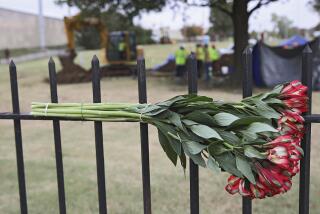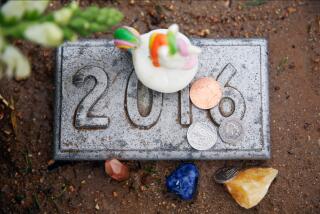The unclaimed ashes of hard times
STEPHEN KEMP
Funeral director
Stephen Kemp rummaged through a supply closet for a box of staples, being careful not to jostle the blue paper bags of cremated remains on the floor.
It’s not a great spot for ashes, but he ran out of space long ago. In the grand scheme of things, the closet is as good a resting place as any.
Kemp, the owner of Haley Funeral Directors, is used to a certain rhythm of life and death.
Good times mean fancy funerals -- open bars with top-drawer liquor, horse-drawn carriages, jazz bands for all-night jam sessions. Bad times mean unclaimed remains -- funeral fees often being a low priority for the living.
“Who can blame them?” Kemp asked.
The dead started arriving last fall, after the Oakland County medical examiner’s office had accumulated too many unclaimed bodies in its storage coolers. In some cases, the next of kin couldn’t be found; in others, relatives didn’t have the money for a burial. Several of the deceased had been kept nearly a year.
Could Kemp cremate them?
He thought about saying no, because it was probably a losing proposition. Once he took the bodies, they were his responsibility forever.
But he relented. “Someone had to do it,” said Kemp, 50, who took over the funeral home in 2003.
Each cremation cost him $895. In theory, the next of kin could apply for $427 in state cremation assistance and then pay the funeral home the remaining $468.
Only two families paid the fees. Kemp offered to give people the ashes, but some next of kin didn’t want them or didn’t know what to do with them. So, left with a dozen or so remains, he tucked them away beneath boxes of pens and stacks of printer paper.
Kemp, a burly man in an ill-fitting black suit, has also had to scrimp. Outside, the roads were icy and the sky was threatening snow. It wasn’t much warmer inside the century-old building.
Kasondra Smith, a part-time funeral director and retired Ford Motor Co. supervisor of line production, bustled into the business office, clutching a thick sweater around her slender body.
“Chilly, huh?” she said.
He nodded. To save money, he keeps the lights off and the heat turned down between funerals. Kemp doesn’t mind the cold. Neither, he figures, do the dead.
Among the bags are the remains of a truck driver, a machinist, a salesman, a master plumber, a paramedic.
One holds the ashes of Bonnie Keith. She was 80, earning a modest wage as a cashier when she died last August. Her son, who lives in Kentucky, had explained to the medical examiner’s office that he didn’t have the money to travel to Michigan to claim her body or pay for a burial.
Four bags away are the remains of Roger Paul Conklin, a truck driver who was 47 when he died. His sister, an inventory manager at a Walgreens drug store, hadn’t spoken to him in years and didn’t have the money either.
“We live paycheck to paycheck,” said Nancy Denault, 51. “There’s no money for anything.”
Having spent almost his entire adult life around funeral homes, Kemp was familiar with these laments. He hefted a foot-thick stack of Manila folders and walked down a hallway to his office. He dropped them on a round wooden table.
Kemp thumbed through the sheets of paper detailing the cases of his unclaimed dead.
He has been intrigued by the files. He wondered how hard it must be for relatives to leave their kin with a stranger, and why some people were seemingly mourned by no one.
“I can’t help but think that these are real human beings and, for the grace of God, they could be any one of us,” he said.
Setting aside the folders, he crossed the mortuary’s light oak parquet floor and headed downstairs to the basement to search for space. The air smelled sharp from cleaning solution.
He passed the embalming room with its empty gurney, flipped on the fluorescent lights and stepped into the storage area. Overhead, the bulbs flickered on.
A tan storage cabinet stood against one wall. He peeked inside. Dozens of urns filled the metal shelves.
Kemp squeezed past the line of caskets, inching around a white one edged with carnation-pink streaks and rolling aside another carved with images of Christ’s last supper.
He stepped into an alcove lined with sagging cardboard boxes containing cremation urns that had accumulated at Haley Funeral over decades of boom and bust.
He picked up a few urns sitting at the top of one box.
The labels had yellowed, but the dates were clear.
1931. 1933. 1938.
On the Edge Staff writer P.J. Huffstutter and photographer Genaro Molina are traveling the country, chronicling the hopes and struggles of Americans in this time of economic hardship. latimes.com /hardtimes Find stories from this series and from the Business series “Surviving Recession: A Consumer Guide.”
More to Read
Start your day right
Sign up for Essential California for news, features and recommendations from the L.A. Times and beyond in your inbox six days a week.
You may occasionally receive promotional content from the Los Angeles Times.






